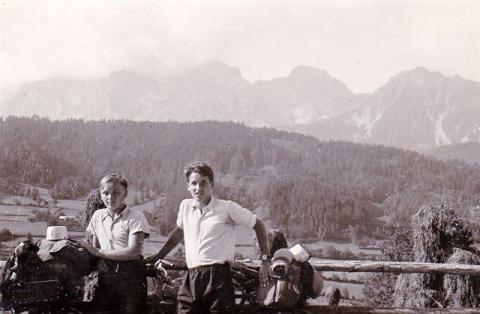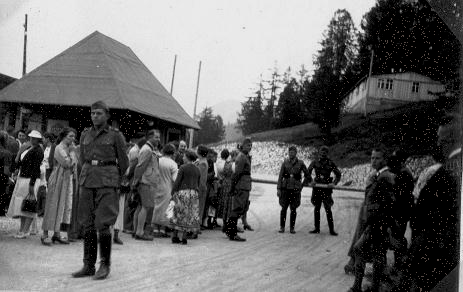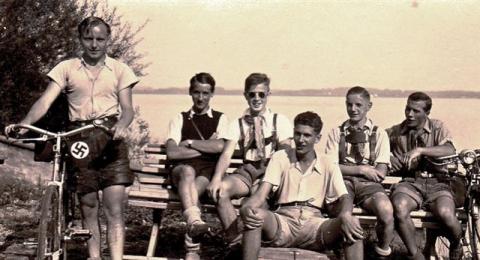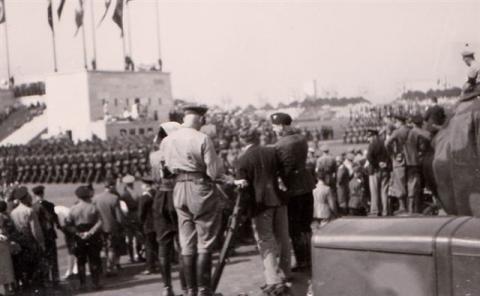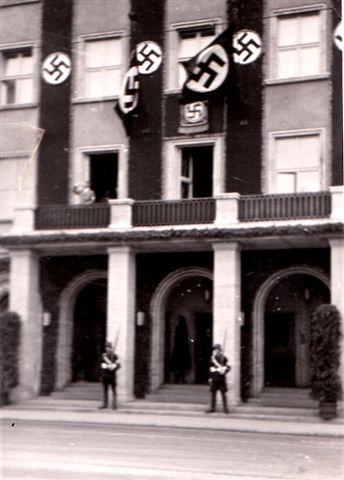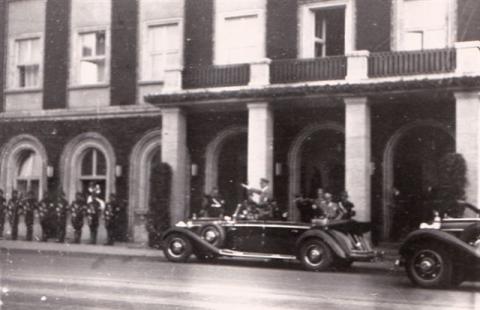Bicycle Adventures of an Austrian Teen - Part Two
From Leopold Wenger's Trip Diary
The Great Ride to Nuremberg
for the N-S Party Convention of 1937
copyright 2013 Wilhelm Wenger and Carolyn Yeager
Translated from the German by Wilfried Heink
Day one - passing the Dachstein mountains on the way to Schladming.
Sunday, August 29, 1937. My buddy Franz and I left Leoben at 6am. When passing the train station I suddenly discovered that I had left my canteen, full of tea, at home. I had no choice but to turn back.
We then continued. It was still cold, and also foggy; our clothes were soon damp. But the fog lifted and at Mauten we stopped for breakfast. Then a headwind picked up, making travel up the Schober Pass difficult. At the top we stopped at a farm to drink some milk; Franz encountered a little mishap but at 11:30 we arrived in Trieben. We did not stop, passed the Wörschach airport and at noon we were already passed Steinach. We rode through an open forest; later in open country with the sun beating down and stopped at an Inn in Diemlern for lunch. The ride from then on was boring, up to Gröbming when I noticed that the houses were different, almost flat roofs with boulders on them. We had climbed quite a ways up and now traveled downhill, the road condition changing. Passing Haus, we had our first glimpse of the Dachstein, with the peak hidden in clouds. At 4pm we arrived in Schladming; the town was celebrating the completion of a new church tower and we had problems getting through the crowds. Uphill from there, and at 4:30 we passed the border between Styria and Salzburg. We already had the Mandling pass behind us.
In half an hour we made it to Radstatt, having to push our bikes up a hill along the way. We looked for the hostel, found it outside the town and registered at 5:30. The pool was a welcome addition and in the evening a youth from Vienna joined us.
Monday, August 30, 1937. It took ‘till 9:30 for us to get our things together so we could finally leave. Downhill to Kreuzberg, then onto the road to Bischofshofen. The wind was from the side, better than headwind, and on towards Salzach. The Werfen castle could be seen from a distance. It then started to rain but soon stopped again. Passing the Luegg train station we noticed that the road was closed.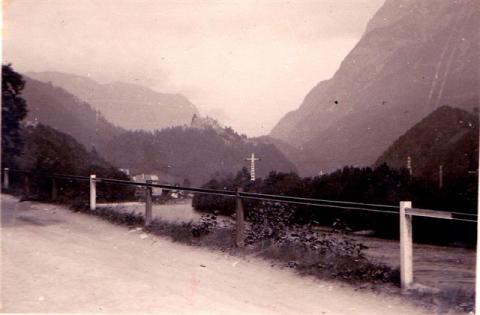
Salzach with the Werfen Castle
Tuesday, August 31, 1937. We met a Sudeten German in the morning, and since he was also heading for Nürnberg, we decided to travel together. We left early, Franz staying behind but planning to catch up. Thus I continued with Wilhelm Bechmit, whom we called “Charles with the Ark of the Covenant,” because his luggage was contained in a crate. We soon reached the Austria-German border, and after some formalities were allowed to move on.
 Right: The road to Reichenhall
Right: The road to Reichenhall
----------------
The international territory stretched on, the road following the border, but finally we entered Germany! At the customs we received receipts for our money and were allowed to travel on, no other formalities. We entered Bad Reichenhall and continued to follow the river Salzach, later resting beneath a colossal aerial cableway. Moving on, we passed two Hitler Youths and asked them if they are also on their way to Berchtesgaden. They laughed and told us that we were going in the wrong direction. We had no other choice but to turn back to Bad Reichenhall. Finding the correct road we continued, uphill, and along the border we could see an SS border guard. We had to dismount, it was hot and at the Hallthun train station we had reached the top. From here we could see the Watzmann and knew we were getting close.
At the Obersalzberg
Directions to the hostel were posted along the way; it was located outside the village - a brand new “Adolf Hitler Hostel”, the best I have ever seen. We registered and, since it was noon, ordered lunch. We sat on the terrace, amidst a group of people from all over: One from Hamburg, from Bavaria, two Americans, my Sudeten German friend and I, the Austrian, four nations together. After a lunch of potato pancakes and cabbage, we stayed together and called ourselves the International Club. In the afternoon, we climbed the Salzberg with the Bavarian in the lead, a 1000m climb, which took us an hour. Up there, I saw minister Hermann Göring by chance and on the way back a rain shower surprised us. We ran to the train station and since a train was about ready to leave we purchased tickets (15 Pf.) and rode to the hostel--the International Club returning to base. Franz had arrived. We spent the evening playing games, also singing. The Hitler Youth Radio Chorus stayed here also.
Wednesday, September 1, 1937. It had rained the evening before but now it was nice. After a short breakfast, we were getting ready to leave but when we picked up our bikes we discovered that a bunch of others were also traveling our way, so we all rode together. We said good by to the International Cub, then back to Bad Reichenhall. We bought groceries, which would last until we reached Munich and then continued in the direction of Teisendorf.
Traveling group assembled at the Chiemsee
Along the road we noticed a number of large Reich labor service camps, housing the men needed to build the Autobahn. We stopped at a larger farm and all seven of us received some buttermilk and bread, free of charge. We then passed through a tunnel, the Autobahn above us, to later view the straight line of this gigantic Autobahn as we climbed. We reached Traunstein at noon and were very hungry. We again rode to a farm, six of us now (one had left) and purchased a big jug full of milk. We continued, almost bursting, but still raided a few fruit trees, the ripe fruit begging. Then the Chiemsee. We rode along its shores to Seebrück, but unfortunately signs were posted all along: “No Swimming.” We continued and were able to go swimming when we were outside the village.
The water was cold but we swam to a structure erected by army engineers. We climbed up and chatted with a guard, with the island and castle Herren-Chiemsee in the background. We then swam back and it didn’t take us long to get to Hamhof, where we left the road and found a nice hostel. We placed luggage on our beds to show that they were occupied and then returned to the village to spend some time at an Inn, bowling. We returned at 8:30 and were read the riot act by the hostel Mom, who had become famous as we later found out. A few more songs and to bed.
Thursday, September 2, 1937. Next morning we rose early and left without breakfast, the packing of the bikes by now routine. But soon we again stopped at a farm to purchase bread and milk. We crossed the river Inn at Rosenheim; the town was festively decked out - some exhibition. We then passed an air force base, stopping to watch planes taking off and land, then continued raiding fruit trees again and at noon we were 27km from Munich.
We were hungry and one of us, from Augsburg, told us that there is a monastery close by, he had stayed in it, and surely we would get something to eat there, free. Around 1pm we arrived, but were told that nothing to eat is left over but to wait, something will be prepared. Fifteen minutes later two nuns appeared, carrying cutlery and a large pot of soup. We ate with relish and believed that this would be it, but no, we were then served meat, vegetables and salad. This really surprised us; we ate what we could but could not manage it all. A big jug of fruit juice finished the meal. We were stuffed, unable to continue our journey.
Served lunch at a Bavarian monastery
Franz lay in the grass, moaning. We were then allowed to view the beautiful rooms and finally continued, late. Heavy going at first, but we were nearing Munich and 15km outside the city the bicycle path started. We again passed an airport, a plane flying overhead, got lost but finally reached Munich. We passed the Maximilianeum, an imposing structure, then across the river Isar, bypassing the Church of my Lady and city hall to the train station. We were given directions to the hostel and arrived at 5pm. A little tour through town, then to bed at 9pm.
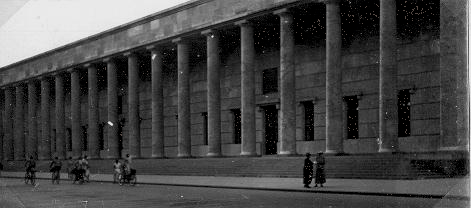
Above: The House of German Art in Munich; below, Victory Gate

Friday, September 3, 1937. No bicycling on this day; we tried to take in as many of the places of interest as possible in a short time: The Temple of Honor (Ehrentemple), The Brown House, The Hall of Heroes (Heldenhalle), the War Memorial (Kriegerdenkmal), Victory Gate (Siegestor), the exhibition of “deranged art,” the English Garden (Englischer Garten) and the House of German Art (Haus der deutschen Kunst). We went to bed in the evening dead tired.

The Temple of Honor (Ehrentemple), Munich

The Eternal Guard (Die Erwige Wache)
Saturday, September 4, 1937. The nicest wake-up call in all of the hostels: At six, the warden of the hostel played his flute, then called out “Get up, comrades.” The last to rise had to sweep the whole place. I slept on the fourth floor. It was 8 am by the time breakfast was over and we were packed; time to say goodbye for Franz and me. Our comrades, the lad from Augsburg, the one from Magdeburg as well as the Sudeten German “Charles with the Ark of the Covenant” (also called minister of finance, as he always managed to find something to eat for little money) planned on staying in Munich, but we had to travel on. As mentioned, we left at eight, and at the army barracks I had my only mechanical defect: a screw had come loose on the fender. The bicycle path was in great shape, we continued through a tunnel and a lad joined us. The road to Pfaffenhofen was almost straight and even. We saw troops, and just outside of Pfaffenhofen we entered hilly country and had to push our bikes at times.
Just outside of Ingolstadt it started to rain, but we continued and arrived in town at 3pm. The town gave the impression of a fortress, and rightly so—castle moats, bastions, walls with gun portals. We found a nice hostel near the Holy-Cross gateway, for now being the only occupants. After a late lunch we walked through town, first to the post office, finding my first letters from home. Market day at the town's square, people everywhere. At the hostel others had arrived, among them a youth from Westphalia, Heinz Borgmann. We visited the tourist information office to pick up some brochures, looked at churches inside and out, the Danube gate—the river still quite narrow here, and to bed at 9pm.
Sunday, September 5, 1937. It was already 8am before we rode off, four of us, and at 9am we were in the old Bishops residence, Eichstätt, having traveled at an average speed of 24kmh. The famous landmarks of this old town were everywhere; Willibald castle on one side, ruins on the other, the Monastery as well as many old Churches. Uphill from here on, not steep but impossible to ride. Markings in the stone showed how the river Altmühl had carved his bed, many holes in rock, with tunnels, easily viewed while pushing the bike. As we climbed, the view of the city, the castle and the monastery became more pronounced. No sun, therefore not too hot, and after a 200m climb we could ride again, but it was not a downhill ride but up and down all along. We rode through Weißenburg; we were in the center of the Franconian Jura. Up on a hill, then down again, not the most pleasant ride. We could now see banners strung over the roads and decorated with flags reading: “Welcome to Nürnberg.”
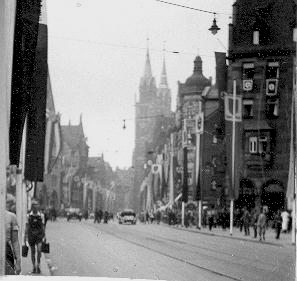
At 2pm we were in the city, saying good by to the others. We rode through town, old streets decorated with numerous flags (shown at right), past the Hotel ‘Deutscher Hof.’ Suddenly a loud roar from above, 450 heavy and light planes practiced the flyover, very impressive. We passed the Zeppelin meadow and ended up outside of Nürnberg, finding a place to stay in a farmer's hay barn because the city was filled to the brim. There we met two other boys, Rolf and Paul, who had also not found a place to stay in town and we made ourselves comfortable, planning on a lengthy stay. The farm was about 9km from town. In the evening, all four of us visited the Reich labor service camp and supper was served to us.
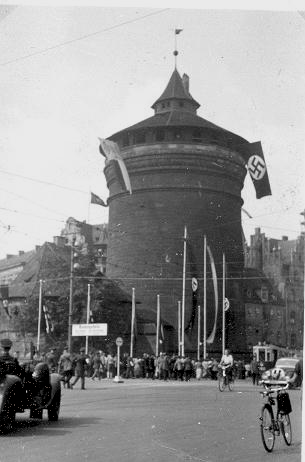
Right: One entrance to the Old Town (Die Altstadt) of Nuremberg.
------------------
Monday, September 6, 1937. We had slept well in the hay, got up at 7:30 and cooked our breakfast in the farmer's kitchen. After tidying up our place, we were ready to leave. On the street, we flagged down a car which took us into town, with one police check along the way. We were dropped off at Langwasser; we still had a long march ahead of us to reach our destination. [This is all that was recorded for this day. According to Willy Wenger, the boys surveyed the tent camp of the 38,000 RAD (Reich Labor Service) young men.]
Tuesday, September 7, 1937: We now decided on a day of rest, laying in the grass all day long soaking up the sun. In the evening we witnessed the practice for the light display, searchlights had been placed around the perimeter of the Zeppelin meadows.
Wednesday, September 8, 1937. Back to town in the morning, a truck driver gave us a ride. This was the Reich Labor Service day; from where we were we could see all the dignitaries of the Reich pass by in cars. A staff officer, who noticed us, gave us two tickets for the events; problem was, there were four of us, so we had to purchase two more. In the meantime, at 10:00, the columns of men were arriving, 38,000 of them marched past the Führer who was standing under the grandstand. We had climbed a light pole and could take it all in. When the parades were over we found a place in a stand at the Zeppelin meadows.
Now the shirtless young men from the Führer school marched onto the meadows – then the Führer spoke. The crowd erupted in cheers. The men from the Labor Service settled down on the meadows, their leaders passing out sweets and oranges, etc. Then the march through town. We, of course, got lost and only met up again in the evening at home—Paul and I not having eaten anything all day.
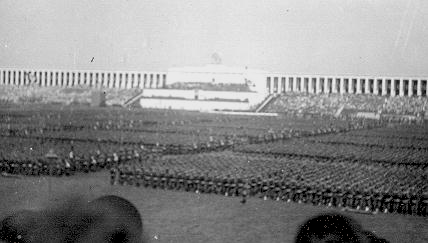
The Reich Labor Service assembled on the Zeppelin Field
Watching the RAD march on the Zeppelin meadow
Thursday, September 9, 1937. Today we left at noon for town, Franz and Rolf were to follow with something to eat. At 6:00pm we were to meet at the post office. There was a lot of commotion in town; huge masses of people were crowding the streets wearing uniforms not from Nürnberg. We walked passed the Deutscher Hof hotel, the place where the Führer was staying, the colors of the Führer flying in the breeze on the roof. The Führer was home. Impossible to imagine the crowds around the hotel; I almost lost Paul. One just had to go where the crowd did, no turning left or right freely; all were waiting for the Führer to appear.
Right: Hitler appears on balcony.
----------------------
I was extremely lucky that after only 10 minutes one of the balcony doors opened and the Führer stepped out to greet the crowd. The four thousand or so present broke out in cheers, the hail shouts not ending even after the Führer had left. When the crowds dispersed I was able to make my way right up to the barrier that was cordoning off the wide walkway between the hotel and the street. I had to wait for quite some time—political dignitaries passed by at times, the two SS honor guards saluting smartly. The SS guards were relieved every hour, an impressive ritual, the two of them marching by in cadence.
At 3:00, the Führer appeared again on the balcony, a repetition of the first, with again loud cheers from the crowd. We heard that the Führer was to leave at 4 o’clock for the Congress Hall; all waited with anticipation.

Dr. Joseph Goebbels leaves the hotel for the Congress Hall at the rally grounds
An additional honor guard was deployed—12 men, two officers as well as a drummer. Several leaders of the Party (Goebbels, Baldur von Schirach, Heß, and others) left in their cars, greeted fanatically by the crowd when they appeared. Then a motorcycle with a side car, a big yellow flag attached to it, left and we all knew that the Führer would come out in ten minutes. Everyone was tense; close to me a lady from Vienna fainted, SS men had to carry her away.
Hitler leaving the hotel with honor guard and drummer standing at left
A drum beat, the guards saluted and the Führer stepped out, greeting the crowds while stepping into his car, the right arm stretched out in the German salute. The car left slowly, and while the crowds had cheered when the other dignitaries were leaving, there was no comparison to the noise now. For a long time one could hear the shouts from people along the way as the car was passing. Only now was I able to get away from the crowd, and since I had two hours to kill before our rendezvous, I went for a walk in the old part of town. I had seen the castle from afar, apparently closed because of the crowds, and at 6pm precisely Paul and I were at the post office, but no sign of the other two. We were ravished and decided to leave for home, but it was hard to make any headway; the crowds already gathering for this evening's torch parade honoring the political leaders. Only later were we able to flag a car down to take us to our quarters. No sign of Franz or Rolf here either; they returned late. We found enough to eat in one of our old suitcases, turned into an “icebox.”
Friday, September 10, 1937. Getting up in the morning I didn’t feel well; but believed that it would pass. It didn’t. I was dizzy, weak, cold and not even hungry. Then we heard a loud noise from the road, we ran outside, saw a truck and about 50m away a car with its front grill stuck in a creek, but no one was injured. The car, doing 120kmh, had rammed the truck, jumped the ditch, drove onto a field, ran over a tree to finally come to a halt in the creek. Luck was with them, and with a joint effort of 10 SA men and us, the car was again put onto the road, a tire changed and it was able to drive off. I became ill from all the exertion and had to lay down. I had nothing to eat all day save for some unsweetened tea but in the evening I felt better.
Saturday, September 11, 1937: I was fit again, but it was raining and we decided to stay inside. In the afternoon Franz and I rode into town to visit Albrecht Appel, who a few days ago had returned from Palestine. (I had met him at Marburg/Drau for the first time). He had much to tell, had experienced a whole lot. At dusk, Franz and I rode back to Langwasser to watch the fireworks at the Dutzendteich lake; it was very late when we returned home.
Sunday, September 12, 1937. The day of my departure had arrived. I said good-by to Franz, Paul and Rolf, thanked the farmer for his hospitality, and at 7am I was on my bike on a foggy and cold morning. Not very pleasant, especially when traveling alone. At first, I wore my regular trousers, but changed into shorts later. The ride was not very nice, uphill, downhill, and on steep inclines the road was not paved, just sand and still wet from the day before. I got lost once; one car came toward me with minister president Hermann Göring the passenger.
In Neumarkt, a chap asked me where I was heading and then accompanied me. When I told him that I wanted to make it to Landshut, he replied that in no way would he go that far and this ‘super biker’ left me at Hemau. Near Oberwintzer I entered the Danube valley, traveled along the river and arrived in Regensburg at 1pm.
I passed the gorgeous Cathedral and stopped in an inn outside of town, and even though it was late, past 1pm, they served me a pork roast. I also ordered a liter of beer, not even asking the price. The hostess asked if she heard right, and that I wanted a liter. When she served it I knew why, but I managed to finish all of it, not wanting to chicken out. I still had 60km to go, not an easy task. I left the Inn at 2pm, a little unsteady, my feet heavy as lead. And to top it all, it started to rain, but I continued. I don’t remember much of this, but time just flew by. I was aware, however, that because of the fall maneuvers soldiers were billeted everywhere.
At 4:45 I arrived in Landhut, drenched, and I had to look for a long time to find a youth hostel. I then picked up a letter from home at the post office. Only four other guys shared the accommodations, and being dead tired I went to bed early.
Monday, September 13, 1937. After having made some enquiries I decided to take a different road than planned. I originally wanted to ride to Salzburg via Wasserburg but was told that the roads were bad, so I chose a different route and two chaps joined me.
It was 8am when I had my things together and I could leave, the other two had left already. The roads were very wet, it had rained all night, it was foggy and overcast. I soon caught up to the others, but the going was tough because of a head wind; it was also uphill/downhill again. It rained often. I had my raincoat at the ready, draped over the handlebar. We arrived at Vilsbiburg, a nice town where I purchased bread and butter. Finally the weather changed for the better. Metal windmills are everywhere in this area. The road leveled out and a tail wind helped. A thunderstorm came up behind us, the sky pitch black. We peddled like mad, crossed the river Inn just before Ötting and then the rain started. Now we parted company, the two going to Traunstein.
I was alone again, facing a strong headwind and on a gravel road. Noon had passed and I started to look for a restaurant. At about 1pm I stopped in a village but all I could get was a sausage and half an hour later I moved on. Just before Tittmoning, I reached the main, paved, road again. Far down I could see the river Salzach, the border between Austria and Germany. Then the river up to Laufen and from here I could see the Austrian mountains, already covered in snow. In the border town of Freilassing, I stopped to buy some chocolate and cookies and at 5pm I passed the border. This did not take long and I was soon on the way again. The Salzburg castle came into view and at 5:30 I arrived at the hostel I had stayed in two weeks prior. My clothes were drenched, as well as my shoes. Not as many guests this time and Salzburg was also not crowded, the festival being over.
Tuesday, September 14, 1937. I was ready to leave at 7am, but had to wait ‘till 8:30 before the host appeared to return my hostel passport. I was finally able to leave, it was cool and I wore sandals, my shoes still wet from the day before. I used shortcuts, pushing my bike up the Gaisberg and was then joined by a soldier from Salzburg. I had traveled this road a year ago and remembered it well. We advanced only slowly because of a headwind, the wind subsiding a little in the forest but only to then hit us again with a vengeance. Because of the conditions we did not get very far that day. At the Fuschl Lake, I re-discovered the bath hut I had stayed in before. Up a hill, then full speed down to the Wolfgang Lake - the first glimpse at the lake with Saint Gilgen was beautiful, the air clean. The bath huts were of course empty, the season over. Outside Strobl, we rested, raiding an apple tree with the consent of the farmer. My companion was a young, pleasant fellow. The head wind increased in velocity, we hardly moved but in Ischl it suddenly stopped. We now entered a new bicycle path, which followed the river to Traun. Past Goisern, we turned off to circumvent the Pötschen pass, I had bad memories about it from last year. At 1pm we bought some milk from a farmer, to then travel along the shores of the lake to Obertraun. I had also stayed there before. Then we had to push the bikes over a hill.
It took some effort to make it up the steep hill on a gravel road. But at 2:30 we arrived in Bad Aussee sooner than we would have going over the Pötschen pass. Then on the Mitterndorf, also not an easy task but from there we could see the Grimming, mostly covered in snow already. When we arrived in Klachau I took a deep, relieved, breath, then downhill, but steep; my companion dismounted. I stayed on the bike but had a few scary moments, and at the bottom of the hill had to wait some time for my companion to arrive. We now increased our tempo, because it was getting dark. In Wörschach the soldier left me and I continued, having to turn on my lights. Past Liezen it started to rain but I hurried on, hoping to catch a train in Selzthal.
I asked for directions and arrived at the station at 7pm, but then was told that the next train would not leave until 9pm. I used the time to catch up on what I had neglected: to eat. The rain now really came down and I was glad not to be on the bike anymore. It had also turned cold. The train left at 9pm, it rained continually. I tried to sleep but was not successful. I dozed a little and just before midnight I arrived in Leoben, my home town. In pouring rain I mounted my trustworthy bike for the last time and arrived home a few minutes later. My 1937 school holiday was coming to an end - a nice, if strenuous, time. Two more days and school would begin again.
A year later 'Poldi was in Nürnberg again, but this time as a legitimate Hitler Youth member. Shown here with friend Gilbert Giesendorfer at the Reichspartitag in 1938.
Category
Adolf Hitler, Austria, Germany, Leopold Wenger, National Socialism- Printer-friendly version
- 4117 reads

